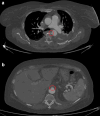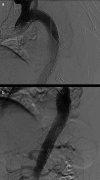Aortic intramural hematoma and classic aortic dissection: two sides of the same coin within the acute aortic syndrome for an interventional radiologist
- PMID: 35300244
- PMCID: PMC8906144
- DOI: 10.1259/bjrcr.20210019
Aortic intramural hematoma and classic aortic dissection: two sides of the same coin within the acute aortic syndrome for an interventional radiologist
Abstract
Management of acute type B aortic intramural haematoma (AIH) still represents a challenging issue. Although most resolve spontaneously or with conservative therapy, several cases of AIH may complicate into classic aortic dissection with subsequent risk of aortic rupture and visceral malperfusion, thus needing urgent or preemptive thoracic endovascular aneurysm repair (TEVAR). Despite the long-term aorta-related survival, TEVAR might lead to graft obstruction, migration, infection, stroke/paraplegia, visceral ischemia, endoleak and, last but not least, retrograde aortic dissection (AD), frequent in the acute phase and associated with a high mortality risk. In order to highlight such a close relationship between AIH and AD and the possibility to perform endovascular treatment, we report the experience of an adult female patient with an aortic intramural haematoma evolving into a classic aortic dissection. Despite successful thoracic endovascular aneurysm repair (TEVAR), our patient developed an aortic dissection type A at one month with subsequent indication for cardiac surgery still representing the elective approach in case of pathologies including the ascending aorta. Thus, the aim of our discussion is to create a debate on the most appropriate management for the treatment of descending AIH.
© 2021 The Authors. Published by the British Institute of Radiology.
Figures




References
Publication types
LinkOut - more resources
Full Text Sources

